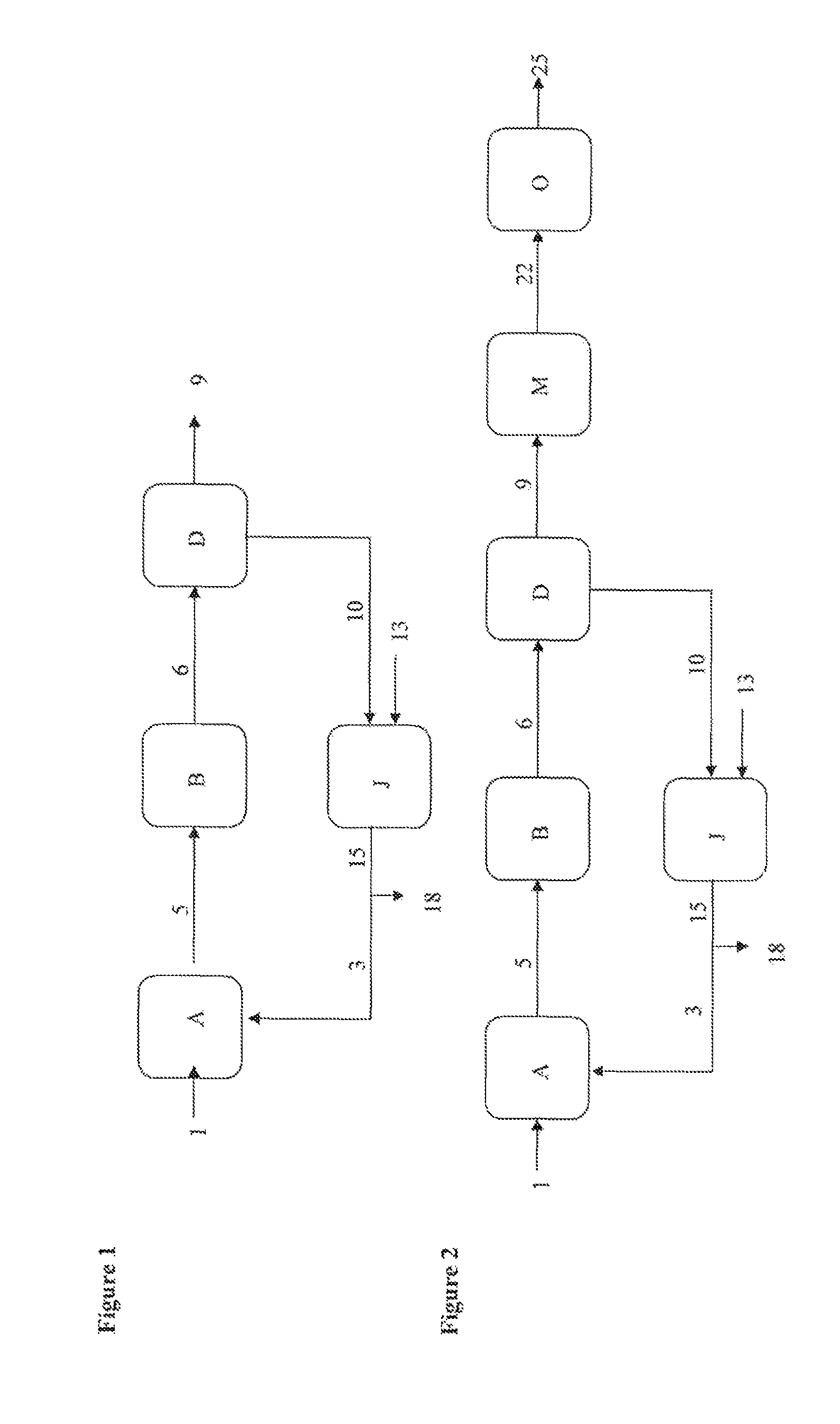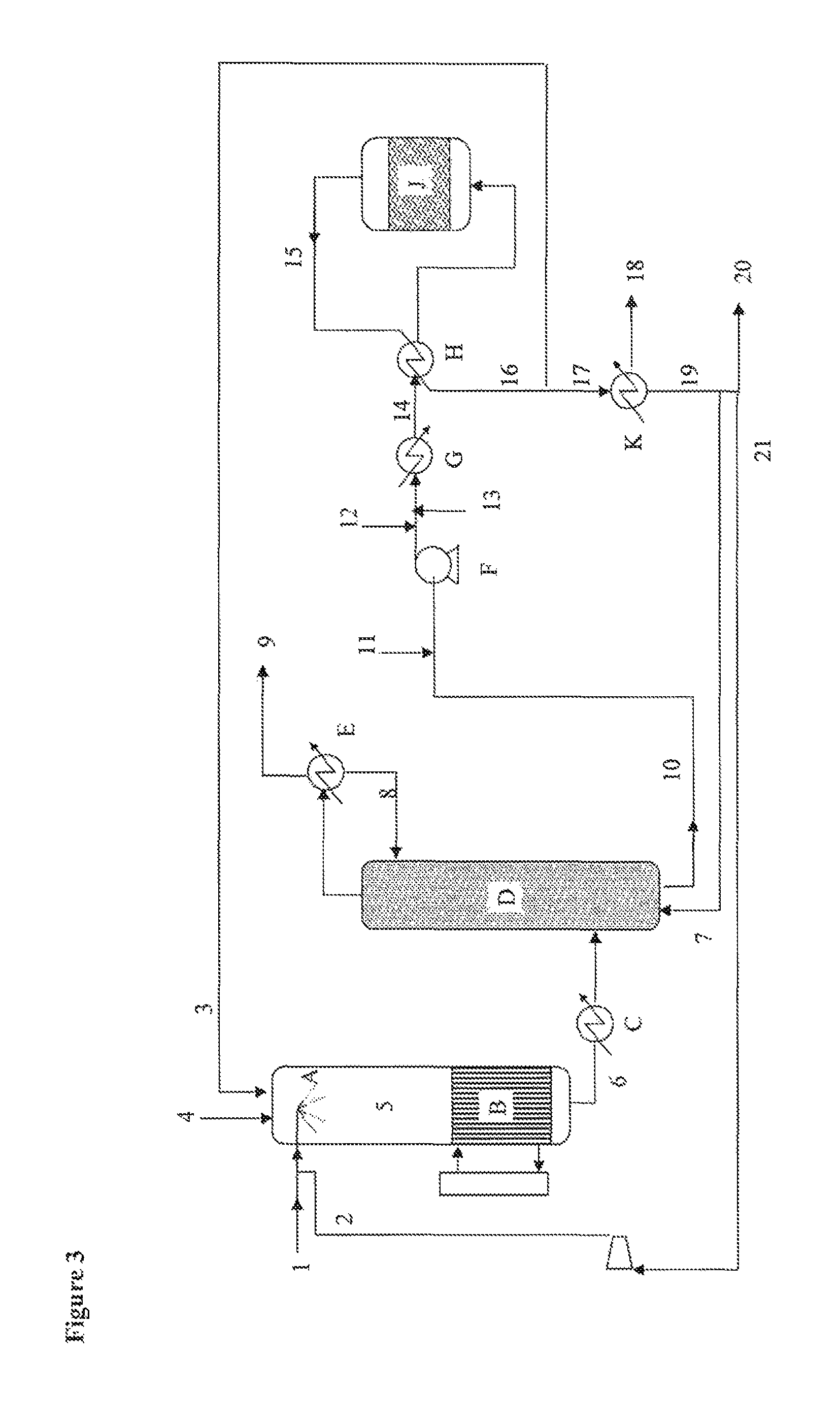Process for manufacturing acrolein and/or acrylic acid from glycerol
a technology of bioresource acrolein and acrylic acid, which is applied in the preparation of carbonyl compounds, organic chemistry, carboxylic compound preparations, etc., can solve the problems of high energy cost, high cost of process using 3-hydroxypropionic acid as starting material, and major disadvantages of the process
- Summary
- Abstract
- Description
- Claims
- Application Information
AI Technical Summary
Benefits of technology
Problems solved by technology
Method used
Image
Examples
example 4 (
According to the Invention)
[0117]A dehydration acid catalyst is prepared by impregnating the pore volume with an aqueous phosphotungstic acid solution (3.9 g of phosphotungstic acid in 5.7 g of water) on a titanium oxide (15.4 g) reduced to a particle size of 300-500 μm. The catalyst is dried in a vented oven at 110° C. and then calcined for 3 hours at 500° C. A volume of 7 ml of the dehydration catalyst is introduced into a 316 l stainless steel reactor of 13 mm diameter placed vertically in an oven heated to 280° C.
[0118]A 15 g / h flow rate of a solution comprising 50 wt % pure glycerol and 50% water is mixed with a flow of oxygen and with a flow of nitrogen of 1.2 and 18 Nl / h respectively and then sent to a vaporizer which heats the mixture to 280° C. and is connected to the reactor.
[0119]The gaseous effluents leaving the reactor are either sent to two traps in series initially containing 120 and 80 grams of water chilled to 0° C., so as to completely trap the acrolein in order to...
example 6
Dehydration of Glycerol in the Gas Phase in Order to Produce Acrolein, which is Oxidized to Acrylic Acid, and Thermal Oxidation in the Gas Phase at Atmospheric Pressure on the Recycled Aqueous Phase
[0130]A liquid glycerol stream (1) (17.4 t / h; 99.0% glycerol) preheated to 275° C. is injected via a venturi mixer into a recycled gas stream (3) (50.6 t / h, 442° C., 3.0 bar; 59.1% nitrogen, 25.3% water, 12.1% CO2, 2.5% O2, 1.0% argon), mixed with a stream of air (4) (20.6 t / h, 172° C., 3.0 bar) and with steam (4.3 t / h, 134° C., 3.0 bar). The venturi-effect mixer serves to vaporize the glycerol over a short distance.
[0131]The resulting gas stream (5) (92.8 t / h, 240° C., 2.8 bar; 18.5% glycerol, 18.5% water, 6.4% oxygen, 6.6% CO2, 49.0% nitrogen) is sent to a fixed-bed multi-tube reactor (B) containing a heterogeneous dehydration catalyst and coupled to a molten salt bath. Leaving this reactor is a gas stream (6) (49.0% nitrogen, 25.7% water, 5.4% oxygen, 9.0% acrolein, 7.2% CO2) at 320° C...
PUM
| Property | Measurement | Unit |
|---|---|---|
| temperature | aaaaa | aaaaa |
| temperature | aaaaa | aaaaa |
| pressure | aaaaa | aaaaa |
Abstract
Description
Claims
Application Information
 Login to View More
Login to View More - R&D
- Intellectual Property
- Life Sciences
- Materials
- Tech Scout
- Unparalleled Data Quality
- Higher Quality Content
- 60% Fewer Hallucinations
Browse by: Latest US Patents, China's latest patents, Technical Efficacy Thesaurus, Application Domain, Technology Topic, Popular Technical Reports.
© 2025 PatSnap. All rights reserved.Legal|Privacy policy|Modern Slavery Act Transparency Statement|Sitemap|About US| Contact US: help@patsnap.com



